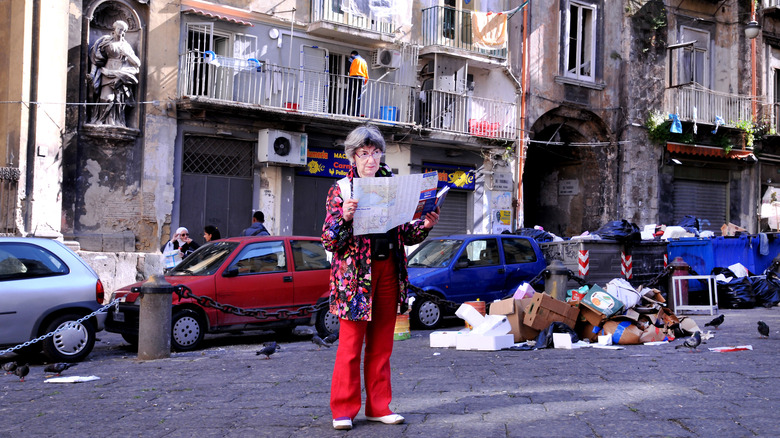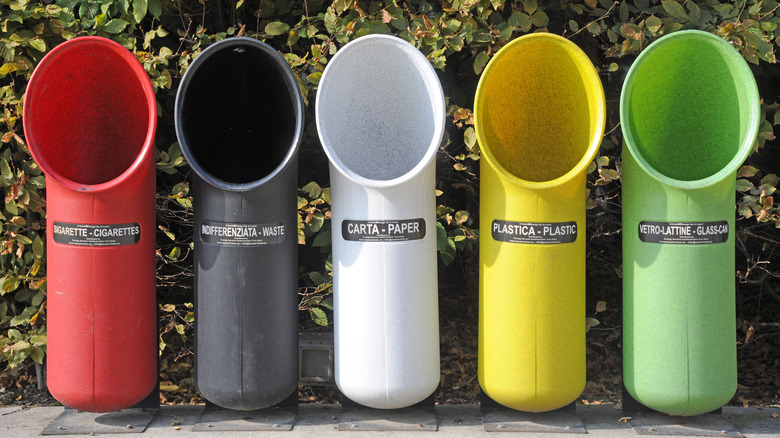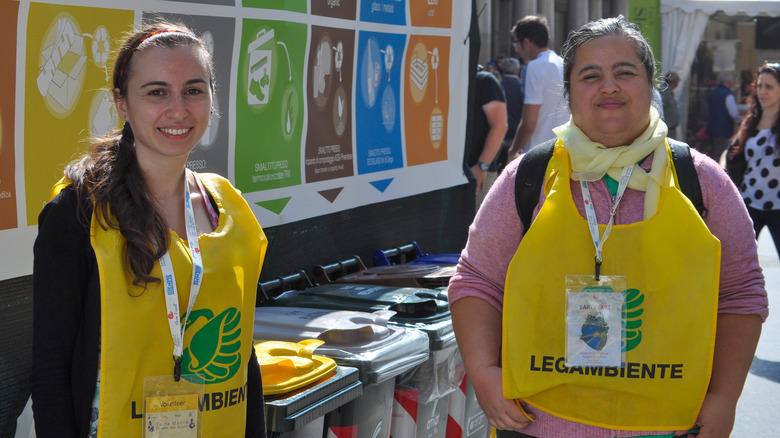Waste-Sorting Rules Tourists Should Know To Be Respectful While In Italy
Italy is a country renowned for its natural beauty, history, and culture, attracting visitors from around the world. But some international guests might find it challenging to adapt to the country's unique and lovely way of life. After all, it is the land of "la bella vita" (the beautiful life). This extends beyond wine, cheese, and romance; it also means knowing how to properly organize the waste you produce on your travels. After all, you can't have a beautiful life without proper waste management.
In order to maintain the beauty and cleanliness of the country, understanding and respecting Italy's waste-sorting rules is essential for tourists — as are some of TikTok's helpful tips for more eco-friendly travel. Unfortunately, about a quarter century ago, Italy faced significant problems with its waste disposal, leading to a state of emergency. However, with the implementation of a legislative decree in 1997 introducing a new strategy, Italy has made remarkable progress. Today, it stands as a proud first-place European leader, recycling 72% of all urban and special-industrial waste. However, Italy's goal is "rifiuti zero" (no waste).
For those who have traveled to Italy more recently, this should come as no surprise. Most, if not all, visitors who have rented an Airbnb, bed and breakfast, or hotel apartment would have already encountered a confusing discovery: several bins of different colors with charming Italian words on them. You don't need to know Italian to get the hint, but what do they mean exactly?
What to know about waste sorting in Italy
The primary categories for waste sorting include: organic waste (umido or organica), recyclable materials (multimateriale or differenziata), paper and cardboard (carta e cartone), glass (vetro), and non-recyclable waste (indifferenziata, secco residuo, or non-ricliclabile). Don't worry about sharpening up your Italian tongue too much as each bin is color-coded. Here is a breakdown of what to put where.
The organic waste bin is brown and meant for all things biodegradable — think food scraps, coffee grounds, and other compostable materials. Recyclable materials are blue, which means plastics, metals, polystyrenes, tetrapaks, and containers. The yellow is designated for paper and cardboard waste. The next one is easy — green for glass, specifically bottles and jars, but not ceramics. Lastly, grey or black for non-recyclable waste should probably be the least full if you sort everything correctly. This would be any item that cannot be put into the other categories, like cigarette butts.
Keep in mind that while Italy has a well-structured waste management system, it varies slightly by region and municipality but generally follows a similar framework. If you're ever confused, icons often accompany the words and colors to help. In some cases, like at private stays, you may need to take the waste to designated municipal bins yourself (don't expect to find in-sink garbage disposals at your Airbnb), for which you'll need a special card provided by your host. Regardless, it all eventually gets taken to the "Isola Ecologica" or Ecological Island. Even in waste management, Italians add a touch of poetry!
Special considerations, tips, and alternatives to less garbage
There are special considerations regarding hazardous waste, like electronics, chemicals, or extra large items, which might require a visit to the ecological island. Your host, hotel staff, and locals can provide valuable information about the sorting rules in the area you are visiting. You can also find a waste-sorting guide or use an app like Junker, which allows users to scan the barcode of an item to get information on where to dispose of it based on their location. With all these systems in place, you can see why respecting these rules is important. The last thing anybody should do is litter. In fact, Italy has strict laws against littering that apply to tourists too and can result in significant fines of up to $375.
The truth is, the less waste you produce, the less you need to worry about disposal practices and littering (although it does get easier once you get the hang of it). One way to minimize your carbon footprint while traveling is to use reusable shopping bags, a commonplace practice in Italy — polyethylene plastic bags have been banned since 2011, making Italy the first European country to do so. Now, only cloth, paper, or biodegradable plastic bags are allowed. Italy takes recycling seriously and has even imposed a plastic tax on manufacturers and importers. Ultimately, by adhering to these considerations and tips, you can contribute to a cleaner environment and enjoy a sustainable, bella vita experience in Italy.


